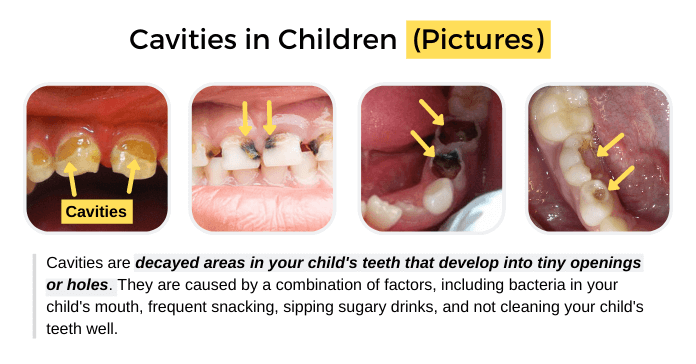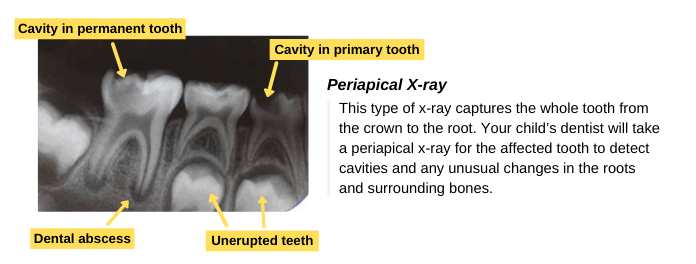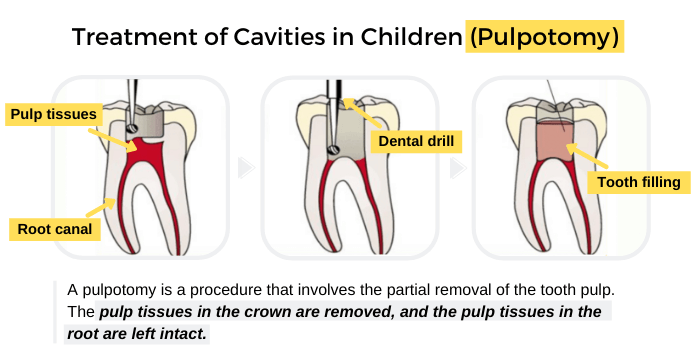Teeth have an impact on your child’s overall health. They help cut and grind food before swallowing and digestion. Also, they help your child to pronounce words correctly. Cavities in children can cause nutrition problems and speech problems. The risk of cavities in children begins with the eruption of the first primary tooth, which occurs at the age of 6 months.
If you don’t clean your child’s teeth well, certain bacteria in the mouth convert food particles into acid. This acid breaks down the tooth enamel, causing holes in the tooth. These holes are known as cavities. They become bigger over time and may reach the tooth pulp, causing pain and dental abscess.
Symptoms of Cavities in Children
The signs and symptoms of cavities in children vary, depending on the size of the damage. In the early stage, dental caries appears as white spots or lines on teeth surfaces, which occur due to the loss of tooth minerals (demineralization). However, the tooth enamel is still intact. In this stage, you may not feel any pain at all, and dental caries can be reversed by fluoride (remineralization). As caries advance, brown or black holes begin to form, which are known as cavities. In this stage, dental caries can’t be reversed, and your child may need tooth fillings to restore the shape and function of teeth. Signs and symptoms of cavities in children include:
- White spots or lines on teeth surfaces (early stage).
- Black or brown holes (advanced stage).
- Sensitivity to sweet, cold, or hot.
- Pain with chewing or biting.
- Sharp, continuous pain.
- Gum swelling.
- Swelling of the face.

Causes of Cavities in Children
Bacteria in the mouth feed on carbohydrates and produce acid. This acid breaks down the tooth outer layer (enamel), causing the formation of holes or tiny openings in your child’s teeth. These holes are known as cavities. These cavities may extend to a deeper layer (dentin), causing sensitivity to sweet and/or cold. Untreated cavities in children may reach the inner of the tooth (pulp), causing continuous sharp pain and dental abscess.
Risk Factors
The factors that increase the risk of cavities in children include:
- Poor oral hygiene: if you don’t clean your child’s teeth well, plaque will accumulate on the teeth surfaces. Dental plaque is a sticky, colorless film of bacteria that gives rise to gum disease and cavities.
- Sugary foods and drink: bacteria feed on sugary foods and drinks and produce acids that break down the tooth enamel. The more sugary foods your child eats., the higher the risk of cavities.
- Not getting enough fluoride: fluoride plays an important role in the prevention of cavities in children.
- Dry mouth: it is usually a temporary condition that occurs as a result of dehydration or long night’s sleep. The problem can be quickly solved with a cool glass of water. However, dry mouth sometimes occurs because salivary glands stop functioning properly. In this case, you need to visit your doctor. Saliva is the first line of defense against oral bacteria. Low salivary flow can lead to significant health issues such as bad breath, gum disease, and dental caries.

Complications
Untreated cavities in children can lead to complications such as:
- Continuous pain.
- Pain with biting or chewing.
- Nutrition problems due to chewing problems.
- Dental abscess and gum swelling.
- Tooth loss.
- Permanent teeth misalignment because of the early loss of primary teeth.
Diagnosis of Cavities in Children
Your child’s dentist can spot cavities early and treat them. So, you should visit your child’s dentist at least once every six months for a regular check-up. Methods that your child’s dentist will use to detect cavities include:
- Oral Examination: the dentist use a mirror and probe to detect cavities in upper and lower teeth.
- X-rays: also, your child’s dentist will use x-rays to detect cavities, especially interproximal cavities. Types of x-rays include:
- Periapical x-rays: this type of x-ray captures the whole tooth from the crown to the root. Your child’s dentist will take a periapical x-ray for the affected tooth to detect any unusual changes in the roots and surrounding bones.
- Panoramic x-ray: this type of x-ray images the entire mouth. Your child’s dentist may ask for a panoramic x-ray check the condition of erupted and unerupted teeth. Also, to check the development and growth of your child’s teeth.

Treatment of Cavities in Children
The treatment of cavities in children varies, depending on the type of the tooth (primary or permanent) and the size of the cavity. The treatment includes:
- Fluoride varnish or gel: in the early stage, dental caries appear as white spots or lines on teeth due to the loss of tooth minerals (demineralization). In this stage, dental caries can be reversed by fluoride (remineralization). However, if cavities begin to form, they can’t be reversed.
- Tooth fillings in children: types of tooth fillings include:
- Amalgam fillings: they are strong, durable, and less expensive. However, they are metallic-colored (unaesthetic).
- Tooth-colored fillings: for example, composite and glass ionomer. They give a more natural look (aesthetic). However, they have a higher cost and may not last as long as amalgam.
- Pulpotomy or pulpectomy (primary teeth): if cavities reached the inner of the primary teeth (pulp), your child’s dentist may remove the pulp tissues partially (pulpotomy) or completely (pulpectomy). In the pulpotomy, the dentist removes the pulp tissues from the crown and the pulp tissues in the root canals are left intact. While in pulpectomy, the pulp tissues are completely removed from the crown and root canals.
- Root canal treatment (permanent teeth): if cavities extended to the pulp of permanent teeth, the dentist may perform a root canal treatment. First, the dentist will completely remove the pulp tissues from the crown and root canals. Then, they will clean the root canals with a disinfectant solution and fill them with a filling material (gutta percha).
- Dental crowns: If your child’s tooth is damaged, your child may need a dental crown. dentists usually recommend dental crowns, for example, a prefabricated stainless steel crown, after a pulpotomy, pulpectomy, or root canal treatment.
- Tooth extraction: your child’s dentist may recommend tooth extraction if the tooth is severely damaged, and can’t be restored by tooth fillings, root canal treatment, or dental crowns.

Prevention of Cavities in Children
To prevent cavities in children:
- Maintain good oral hygiene:
- Babies: clean your baby’s gums with a moist gauze pad after feedings.
- Toddlers: brush your toddler’s teeth with a small, soft toothbrush. Don’t use toothpaste.
- School-age children: brush your child’s teeth regularly with a soft-bristled toothbrush. Also, use a tiny amount of fluoride toothpaste.
- Floss daily: floss your child’s teeth daily to remove food particles from between teeth and from places that toothbrush can’t reach.
- Limit foods and drinks high in sugar: encourage your child to eat healthy foods rich in proteins and calcium. Also, limit foods and drinks high in sugars and refined carbs. Replace sugary snacks with fruits. Besides, tell your child to drink water after sugary snacks or drinks.
- Fissure Sealants: ask your dentist to apply a protective plastic coating (dental sealant) on the chewing surfaces of your child’s back teeth to protect them from molars cavities.
- Visit the pediatric dentist regularly: to detect cavities earlier and treat them before it’s too late. Also, to check the growth and development of your child’s teeth.
Summary
- Teeth help your child cut and grind food and pronounce words correctly.
- Cavities in children can cause nutrition problems and speech problems.
- They appear as brown or black holes in teeth.
- Cavities are caused by a combination of factors, including consumption of sugary foods and drinks and poor oral hygiene.
- The treatment includes tooth fillings, pulpotomy for primary teeth, root canal treatment for permanent teeth, or tooth extraction.
- To prevent cavities in children, brush your child’s teeth regularly, and encourage them to eat healthy foods.
- Also, consider the placement of fissure sealants on the chewing surfaces of your child’s back teeth (molars) to protect them from cavities.